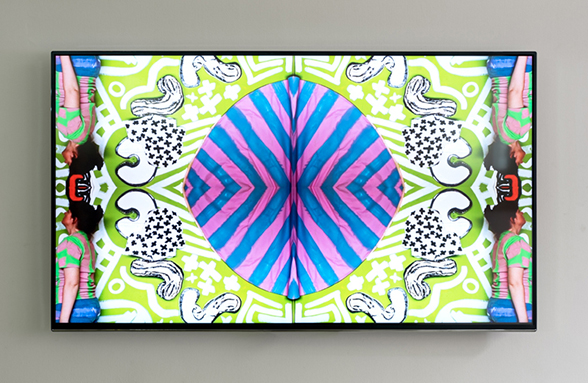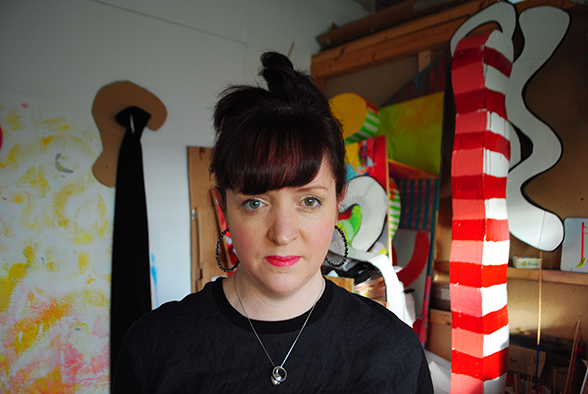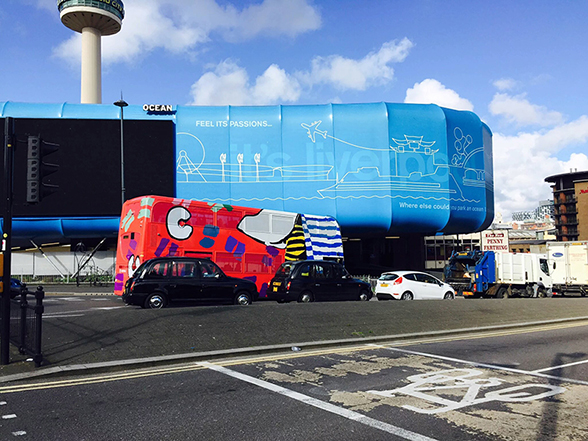Rhythms and Speeds: The Story Behind #BlazeBus
Posted on 4 September 2016 by Guest Blogger
Frances Disley, Blaze, 2016. Courtesy the artist
Liverpool-based Frances Disley is the artist behind the moving double-decker artwork, Blaze, and a Liverpool Biennial Associate Artist. Inspired by the 90's TV show Gladiators and the physical journey its characters take, the artist leads us through the creative process behind her Biennial artwork.
Rhythms and Speeds
I’m currently fascinated by the repeated journey I take when making an artwork: the common rhythms and speeds that re-occur, and how they relate to the start and end point of a piece. I was pleased to have been selected to take part in the Liverpool Biennial Associate Artists programme – a three-year scheme that gives the opportunity to travel and develop an international presence whilst being based in the North.

Frances Disley, I'm a really good dancer, 2016. Installation view at India Buildings
So, if you are sitting comfortably, I’d now like to take you with me on a short journey through the story behind Blaze. If you like, take a moment to breathe in through your nose and out through your mouth, let your surroundings drift away, and follow these steps. If you wish to leave at any point, feel free to do so, you can always pick up again at a later time.
Warming up
My work often begins with playful activity in the studio, which I currently think of as a kind of constantly evolving ‘set’ and place where limitless influences can seep in – no matter how ridiculous they may later seem.

The Biennial’s invitation to create a design for a double-decker bus made me think of what this action could signify. I would be covering or dressing it up in some way, making it more unique, even possibly concealing its identity. I also trained as a printmaker and am interested in process and how artists choose to translate their ideas, so the prospect of having my design realised by the expertise of the Arriva bus painters sounded like an exciting prospect.
I would like to expose the act that takes place in the studio by incorporating myself into the work, and becoming a part of it.
Action!
Blaze, the title of my design, was inspired by the 90’s TV series Gladiators. In the show, members of the public would compete against professional athletes (Gladiators) in a contest of physical strength and endurance. The contestants would take part in the Joust, The Wall, Hang Tough and the Eliminator, all of which took place in an oversized outlandish stadium. There was only ever one contestant so successful that she was invited back to become a Gladiator herself: Eunice Huthart from Liverpool, whose Gladiator name was ‘Blaze’. I liked the idea that this bus had been selected to become something beyond the everyday, something a little more heroic.
Warming down
The Eunice Huthart reference came after the artwork had been created: it seemed to make a lot of sense to me when reflecting on what I had made. I compare the idea of being an artist who attempts to be heroic, when I really I am not, to Eunice triumphing at Gladiators when she was (I think) managing a McDonalds. When asked what I do, I often don’t feel comfortable offering up the response of ‘artist’. I find it exciting the way Huthart made the producers re-write the rules of the show to become part of its cast, even though she only lasted one season.

For me, using something as high camp and surreal as Gladiators points towards how all kinds of thoughts can leak into your subconscious when creating an artwork. As a lot of my practice is based around a kind of free play in the studio, I often try to clear my mind of overly conscious references to begin with, and then unpick and consider the external anchors afterwards. Eunice Huthart is now a successful stunt woman standing in for Uma Thurman, Famke Janssen and Milla Jovovich.
Stretch out
Please feel free to pause for a moment and, if you have some water, take a few sips – but remember to breath.
I am amused by the idea that I could have become a kind of super hero within my work, with the pointless power to blend in. This possibly plays on the idea of portraying myself as humble shy apologetic artist, whilst rendering the notion mute by painting myself in bright colours on the side of a double-decker bus.

Super hero aside, I am interested in the idea that an artist could have a transcendental experience with their materials in the studio, which could then be transferred to the viewer. That Blaze might eventually be absorbed into people’s consciousness in Liverpool, like a distant memory of a Zumba class they tried out once but couldn’t make the time for later down the line, leaves me happy.
Have you spotted Blaze out on the road? Check @arrivanorthwest on Twitter to find out its route on any given day, and tweet us your photos using #BlazeBus.
Visit other work by Frances Disley and the rest of the Liverpool Biennial Associate Artists exhibited at India Buildings, open daily throughout Liverpool Biennial 2016. View Disley's website here.
Liverpool Biennial
55 New Bird Street
Liverpool L1 0BW
- T +44 (0)151 709 7444
- info@biennial.com
Liverpool Biennial is funded by
Founding Supporter
James Moores
